Thunderbolt 3 in Action: Akitio Thunder3 Duo Pro DAS Review
by Ganesh T S on April 14, 2016 8:30 AM EST- Posted in
- Storage
- DAS
- Thunderbolt 3
- Akitio
The Nuts and Bolts of Thunderbolt 3
In order to understand and appreciate Thunderbolt 3, it is important to look at how Thunderbolt has evolved over the last five years. Thunderbolt was launched in 2011 to provide a unified interface with enough bandwidth to satisfy virtually everything needed simultaneously in terms of external I/O and display output. The first two versions shared the same cabling and connectors as mini-DisplayPort. They essentially muxed / demuxed PCIe lanes and DisplayPort lanes over a Thunderbolt cable using Thunderbolt controllers.
At the time of its launch, Thunderbolt was facing competition from USB 3.0 which had already seen a lot of adoption on the PC side. The parallels between USB 2.0 / FireWire and USB 3.0 / Thunderbolt were difficult to ignore. Even after Thunderbolt 2 was launched (with the ability to aggregate the two discrete bidirectional 10Gbps channels in the first version of Thunderbolt), the perception remained that it was relevant only to Mac users. Despite a number of PC components with Thunderbolt 2 integrated, Windows users never found the technology to live up to its advertised potential. Common complaints included peripherals not carrying certification for use on PCs, peripherals outright not working on PCs, unreliable hot-plugging and degraded performance compared to what one could obtain with the same device in a Mac.
In 2012, Intel luanched an Ivy Bridge NUC with Thunderbolt integrated. Unfortunately, the issues cited above resulted in Thunderbolt getting completely dropped from the NUC lineup. It was a golden chance for Intel to drive up Thunderbolt adoption, but, the overall peripheral market put a spanner in the works.
Thunderbolt 3 and Type-C
While the 'Thunderbolt for PCs' market was trying to build momentum, USB-IF started to finalize the specifications for USB 3.1 that could deliver up to 10 Gbps of theoretical bandwidth. By mid-2015, the USB consortium had announced both 10Gbps “Superspeed+” USB 3.1 Gen 2 and the new USB Type-C connector, a compact, reversible connector designed to drive the standard for the next decade or more. The introduction of USB Alternate Mode functionality – the ability for USB Type-C to carry other protocols along with (or instead of) USB Superspeed data – made USB more flexible than ever. VESA had also announced that DisplayPort would be supporting alternate mode to deliver DisplayPort video over USB Type-C ports and cables.
At Computex 2015, Intel announced Thunderbolt 3. It marked a shift in the signaling layer from what was used in Thunderbolt 1 and Thunderbolt 2. This was done in order to support more bandwidth per cable. By taking advantage of USB Type-C's alternate modes (i.e, the four high-speed data lanes in the Type-C specifications), Thunderbolt 3 became a standard built on top of the USB Type-C port.
Along with the change in the cable and connectors, Thunderbolt 3 also upgraded the total available bandwidth to 40 Gbps. Thunderbolt 3 also updated the active cables with electronics at both cable ends to support full bandwidth. With the usual Type-C cables, Thunderbolt 3 drops down to 20 Gbps.
Intel also markets Thunderbolt as the 'Type-C that does it all'. It is easy to see the reason behind this.
Consumers should always check the logo next to their Type-C port in order to identify the capabilities of the port in terms of the bandwidth available, power delivery capability and DisplayPort carriage support. Intel wants to bring it across to consumers that the Thunderbolt logo encompasses all these capabilities. Readers might wonder where the USB 3.1 capabilities suggested above come from. This is where the Alpine Ridge controller comes into the picture.
The Alpine Ridge Controller
Intel's chipsets usually take a generation or two after the introduction of any I/O version update (say, SATA II to SATA III, or, USB 2.0 to USB 3.0) before getting native support for the latest version. In the meanwhile, motherboard vendors resort to third-party bridge chips that interface with the PCH using PCIe lanes to provide the latest and greatest I/Os. The same thing is happening currently with USB 3.1, and this is where Intel has found a way to sneak in Thunderbolt support into more systems.
Intel's Thunderbolt 3 controller (Alpine Ridge) also integrates its own USB 3.1 (Superspeed+) host controller, which in turn serves dual purposes. When serving as a host controller for a USB Type-C port, this allows Alpine Ridge to directly drive USB 3.1 device if they’re plugged into an Alpine Ridge-backed Type-C port (similar to how DisplayPort works today with Thunderbolt ports). And when serving as a device controller (e.g. in a Thunderbolt monitor), this allows devices to utilize and/or offer USB 3.1 ports on their end.
Given that motherboard vendors integrate a USB 3.1 Gen 2 bridge chip in most mid-range and higher products, it actually costs them only a slight premium to go in for Alpine Ridge as compared to, say, an ASMedia bridge chip which can only provide USB 3.1 Gen 2 functionality.
Thunderbolt 3 Usage Scenarios
Thunderbolt 3 enables various scenarios such as a single-cable docking solution for charging, data transfer and display output, and external discrete GPU docks with hot-plug support.
Thunderbolt Networking also allows creation of a 10 Gbps network for peer-to-peer connection between various computing systems (based on a network adapter model in the host OS).
Given Intel's lofty goals with Thunderbolt 3, and the fact that systems with the ability to act as Thunderbolt 3 hosts have been shipping since late last year, it was imperative that various Thunderbolt 3 products enabling the above usage scenarios had to come to the market soon. The credit for being the first shipping Thunderbolt 3 peripheral goes to the Akitio Thunder3 Duo Pro. Intel and Akitio shipped us a couple of units so that we could check out the capabilities of Thunderbolt 3 in practical scenarios.



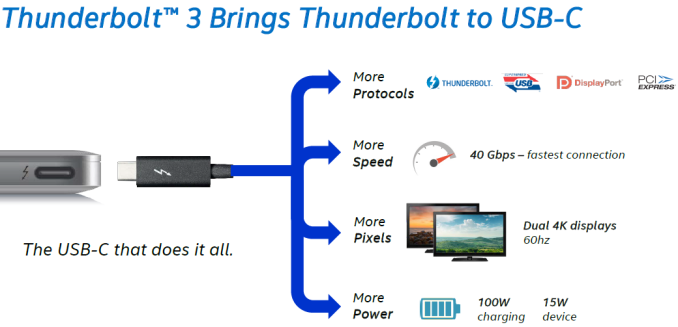
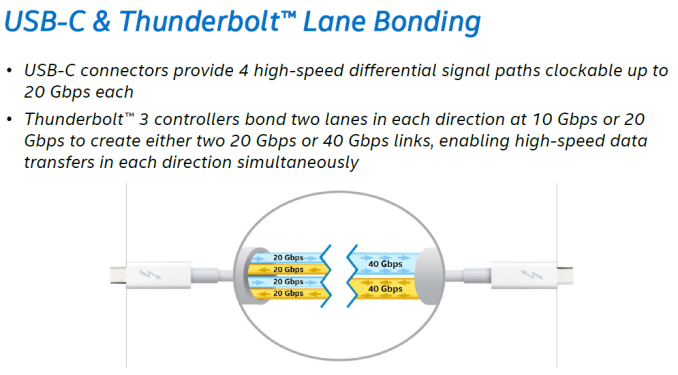
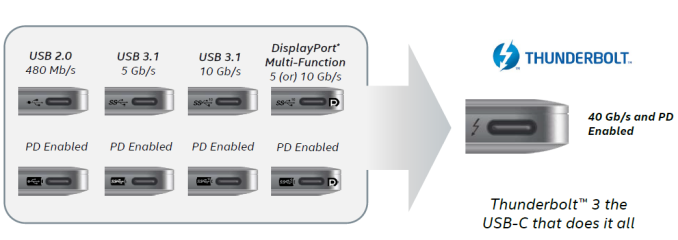
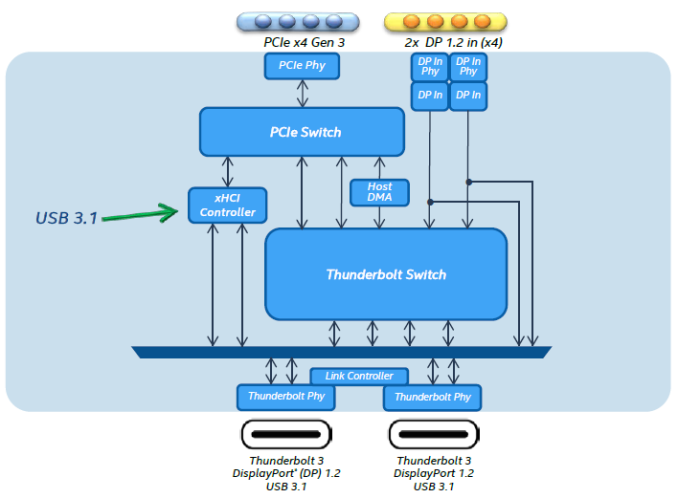
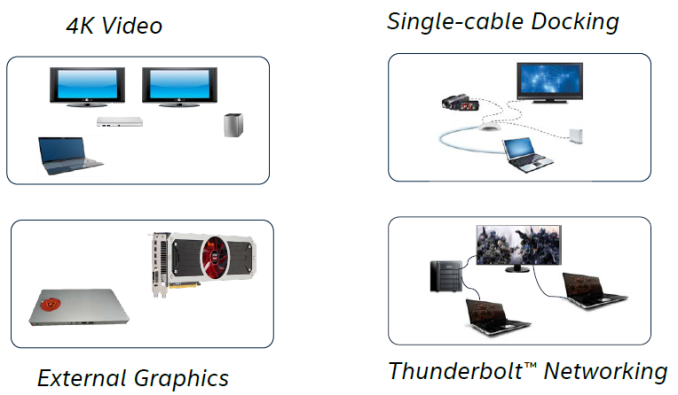








60 Comments
View All Comments
name99 - Thursday, April 14, 2016 - link
There is obviously a market for this sort of thing for SOME people, but if you're trying to save money, the way you do it is to use standard (high-performance) USB-3 cases and software RAID-1; there's no need to do that in the case.OSX and Linux obviously support RAID out of the box; I've no idea about Windows but I'd assume they're also on board. The only reason I can see that you need this hidden behind HW is if you need to move the device between different OS's.
danbob999 - Friday, April 15, 2016 - link
well there is this one for $50:http://www.newegg.com/Product/Product.aspx?Item=9S...
if you don't need a real case there are various dual dock for about $30. I also found dual 2.5" USB3 cases for $25.
Great_Scott - Thursday, April 14, 2016 - link
At $100 over the price of a normal enclosure, no one that really needs the extra features this offers will care. Thus the item will stay niche and the price will stay high.This is self-reinforcing problem.
TB is putting up a good fight, but the future doesn't look bright. No interface has ever survived higher prices by having better features. See: Microchannel, Token Ring, EISA, ATM, e-SATA and, yes, FireWire.
epobirs - Saturday, April 16, 2016 - link
Look at the Cineraid portable models. I picked up one from Newegg a couple of years ago for about $20 because the things weren't selling. Either the target market didn't know they existed or just didn't see the value. Mine still sits unpopulated because I don't have any great need for a somewhat faster USB 3.0 drive, unless I'm getting the drives really cheap. At the time I bought the unit I was getting a lot of requests for laptop SSD upgrades. The customers would either get their original hard put in an enclosure or just let me keep it for a token amount. (I'd label it and put it in a drawer for a month or so, in case the SSD proved defective.)I expected I'd have a couple of drives to use or sell it to somebody converting two laptops but neither situation came along since obtaining the Cineraid.
HideOut - Thursday, April 14, 2016 - link
The good news for us is that you will be asleep until hell freezes over. No more trolling from you.danbob999 - Thursday, April 14, 2016 - link
At $378 I might as well buy a PC... which will be able to hold at least 4 drives.jbrizz - Thursday, April 14, 2016 - link
People are going to plug these things into their Mac Pro, then do some 4k video editing on their 5k screen. You are not it's target audience (although you still shouldn't be so ignorant as to think that just because you don't want/need it no one else will).danbob999 - Thursday, April 14, 2016 - link
That's just one more reason why a Mac Pro is a crap PC. Such a professional PC should include room for at least 4 hard drives. Requiring an external $378 case just to get close to the same performance that you would get with internal drives is a joke.apoctwist - Friday, April 15, 2016 - link
I had to log into the site for the first time because of how silly this comment is. People working in the pro audio/pro video side are not going to rely on internal storage for their work or software RAID. First of all what happens when the machine you are using dies? What happens with your software RAID array on all those internal drives? With this device due to hardware RAID I can just plug in a cable on a new machine and I'm up and running in minutes. I don't have to worry about taking hard drives out of the PC, I don't have to worry about rebuilding the array (if that's even possible since you are using software RAID tied to you OS). All I have to worry about is a cable.That's why devices like these exist. In Pro video workflows external RAID arrays are common and encouraged. You see less heartache in the long run that way.
As an audio professional I have all of my projects/audio/recording on an external TB raid array. if my machine dies tomorrow I can pick up where I left off the next day. I also have multiple machines for DAW work and I can just plug my TB cable to them and continue working on whatever project I need to with no worries.
You are looking at a device like this from a consumer level but that's not what it's made for and the price tag is rather in line with what you will find out there for a TB enclosure.
theduckofdeath - Saturday, April 16, 2016 - link
It might sound like harsh words, but, he is right. At the moment,. everything Mac related is stupid solutions to problems we didn't have. Thunderbolt has to die. It's a way to milk consumers for even more money on relatively limited sales.There are a ton of ways to make a better solution for your external storage you actually need. The first choice is exactly what he said, design the workstation case to allow for stortage expansion, instead of selling people an overpriced and under-powered garbage bin.
There's a reason why companies like Oculus and HTC Vice refuse to support Mac OS these days. Because Mac devices are designed to work against the consumer from the foundation, Thunderbolt being one of the key culprits.